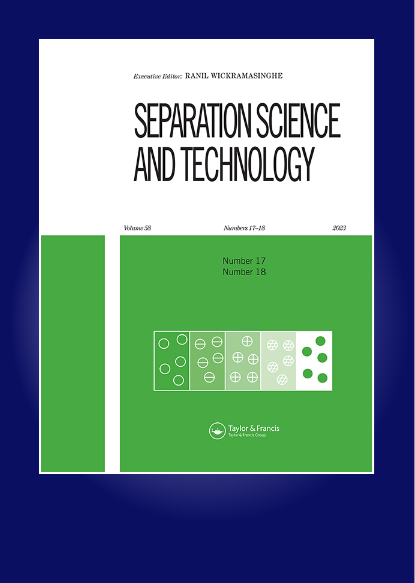推阀离心塔板特点;一种带管式降水管的新型托盘
IF 2.3
4区 工程技术
Q3 CHEMISTRY, MULTIDISCIPLINARY
引用次数: 0
摘要
摘要:本文的目的是对新配置的推阀式离心塔板的流体力学特性进行实验研究,以改进拉万油生产中提馏分油的脱硫目的。利用空气-水模拟装置在工业规模塔上进行了实验。两种不同的中试植物直径分别为1.2米和3米。给出了工业规模1.2 m直径塔柱的干压降、总压降和渗流数据。结果与筛板进行了比较。给出了压降与渗流的关系。此外,还安装了一个直径为3 m的中试装置来预测压降,该装置与拉万制油汽提塔的压降特性完全相同。在不同的操作条件下,分别在0、3 cm、2孔和4%孔两种不同的出口堰高度进行了实验。本文还介绍了一种新型的下水管和离心塔板的设计。实验和工业报告表明,该型离心塔板可用于改造工程。本文章由计算机程序翻译,如有差异,请以英文原文为准。
Characteristics of push valve centrifugal tray; a novel tray with pipe type downcomer
ABSTRACT The intention of providing this paper is to conduct an experimental investigation into the hydrodynamics of the push valve centrifugal tray, which has a new configuration, in order to retrofit the purpose of a stripper oil sweeting of Lavan oil manufacture. Experiments were performed on the commercial scale column by an air-water simulator rig. Two different pilot plants with 1.2 m and 3 m diameter have been used for experiments. Dry pressure drop, total pressure drop, and weeping data are presented on the commercial scale 1.2 m diameter column. The results compared with a sieve tray. Some correlations for the pressure drop and the weeping are presented. A pilot plant with a large diameter, 3 m, was also installed to predict the pressure drop with the exact characterization as the stripper column of Lavan oil manufacture to predict its pressure drop. The experiments were carried out in two different outlet weir heights, 0, 3 cm, and 2- and 4%-holes areas at various operating conditions. This article also introduced a new downcomer and tray design of the centrifugal tray. Experiments and industrial reports of this type of centrifugal tray show that it can be used in revamping and retrofit projects.
求助全文
通过发布文献求助,成功后即可免费获取论文全文。
去求助
来源期刊

Separation Science and Technology
工程技术-工程:化工
CiteScore
6.10
自引率
3.60%
发文量
131
审稿时长
5.7 months
期刊介绍:
This international journal deals with fundamental and applied aspects of separation processes related to a number of fields. A wide range of topics are covered in the journal including adsorption, membranes, extraction, distillation, absorption, centrifugation, crystallization, precipitation, reactive separations, hybrid processes, continuous separations, carbon capture, flocculation and magnetic separations. The journal focuses on state of the art preparative separations and theoretical contributions to the field of separation science. Applications include environmental, energy, water, and biotechnology. The journal does not publish analytical separation papers unless they contain new fundamental contributions to the field of separation science.
 求助内容:
求助内容: 应助结果提醒方式:
应助结果提醒方式:


